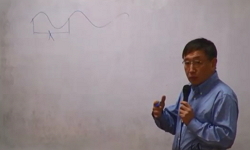In this thesis, productions of the stable microwave oscillators using an extended-cavity diode laser (ECDL) in multimode operation are studied and realized. While in most spectroscopic experiments multimode operation of a laser is not desirable, we in...
http://chineseinput.net/에서 pinyin(병음)방식으로 중국어를 변환할 수 있습니다.
변환된 중국어를 복사하여 사용하시면 됩니다.
- 中文 을 입력하시려면 zhongwen을 입력하시고 space를누르시면됩니다.
- 北京 을 입력하시려면 beijing을 입력하시고 space를 누르시면 됩니다.
부가정보
다국어 초록 (Multilingual Abstract)
In this thesis, productions of the stable microwave oscillators using an extended-cavity diode laser (ECDL) in multimode operation are studied and realized. While in most spectroscopic experiments multimode operation of a laser is not desirable, we intentionally choose operating parameters so that the ECDL produces three modes. An ECDL is a composite-cavity system consisting of a laser diode and an external grating so that it is prone to multimode operation. In addition, the beat frequency between a pair of modes depends sensitively on either injection current to the laser or a piezoelectric transducer (PZT) voltage applied to a PZT attached to an external grating. It allows the beat frequency to be fine tuned by a feedback system and presents the possibility to make a stable microwave oscillator based on an ECDL without using an external local oscillator.
In order to confirm the dynamics of the ECDL in multimode operation, we use a saturated absorption spectrometer and a confocal spectrum analyzer as the optical monitoring systems. A microwave spectrum analyzer and a frequency counter are also used for the microwave monitoring systems. After forcing the ECDL to mul-
timode operation, we lock the phase of the two modes from an ECDL to a stable synthesizer. In this experiment we use a conventional phase lock method. Allan deviation of the beat frequency, when the two modes are phase-locked, drops as an inverse of the measurement time and it reaches 10^−14 when the time is 1 h. We also lock the phase of the two modes with reference to a dispersion signal from a coherent population trapping (CPT) resonance of 85Rb at 3.036 GHz. We measure
the dispersion from the CPT by comparing the phases of the 3.036 GHz beat signals before and after the Rb cell. This experiment is in principle free from an external
oscillator and a modulator and it is significant simplification over a conventional CPT-based atomic clock. Allan deviation of the beat frequency is 1 *10^−10 at 200 s integration time.
In addition, we use an optoelectronic oscillator (OEO), which is stabilized to an intra-loop 85Rb cell with a 3.036 GHz CPT resonance. Our OEO design employs direct modulation of an injection current to an ECDL. In this experiment, the CPT resonance plays the role of a narrow optical band-pass filter. Long-term Allan deviation of the OEO frequency approaches 2*10−9.
To further study the effect of the CPT resonance in the OEO loop, we measured induced frequency shift of the OEO as its loop length is changed. We construct
a set of a corner cube retroreflector with a PZT which is calibrated by using a Mach-Zehnder interferometer. In a simple OEO, the loop length is 27 m which corresponds to a free spectral range of 11 MHz and an induced frequency shift is 111.8 Hz/um. When frequency of the OEO is on the CPT resonance, however, an induced frequency shift is changed to 0.130 Hz/um which corresponds to an effective loop length of 23.1 km.
목차 (Table of Contents)
- 1 Introduction 1
- 2 Theory 4
- 2.1 Coherent population trapping 4
- 2.2 Opto-electronic oscillator (OEO) 15
- 3 Apparatus 19
- 1 Introduction 1
- 2 Theory 4
- 2.1 Coherent population trapping 4
- 2.2 Opto-electronic oscillator (OEO) 15
- 3 Apparatus 19
- 3.1 Characteristics of a multimode laser 19
- 3.2 Extended-cavity diode laser 24
- 3.3 Polarization orthogonalizer and Rb buffer cell 25
- 3.4 Phase measurement system 32
- 4 Experiment 1 : Production of a coherent pair of light beams with a microwave frequency difference 33
- 4.1 Introduction 33
- 4.2 Experimental setup 34
- 4.3 Results 37
- 5 Experiment 2 : Oscillator-free atomic clock using a multimode laser 42
- 5.1 Introduction 42
- 5.2 Experimental setup and coherent population trapping 43
- 5.3 Results 47
- 6 Experiment 3 : Opto-electronic oscillator 51
- 6.1 Introduction 51
- 6.2 Experimental setup 53
- 6.3 Results 55
- 7 Experiment 4 : Frequency pulling effect in an opto-electronic oscillator 60
- 7.1 Introduction 60
- 7.2 Theory 61
- 7.2.1 Frequency shift in an opto-electronic oscillator 62
- 7.2.2 Frequency pulling effect in an opto-electronic oscillator 63
- 7.2.3 Slow light effect along the CPT medium 64
- 7.3 Experimental setup 65
- 7.4 Results 72
- 8 Summary and discussion 78










